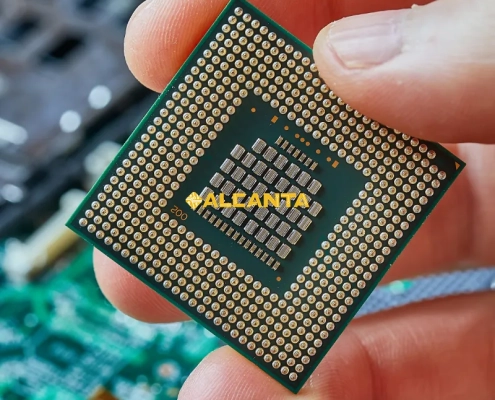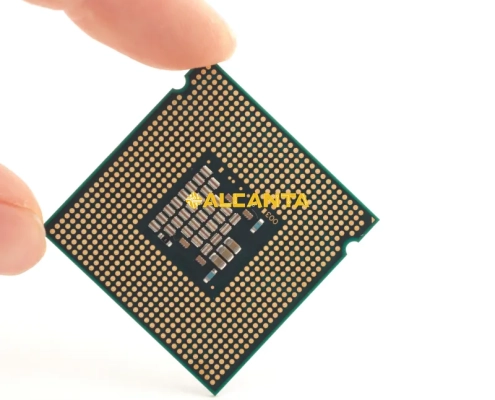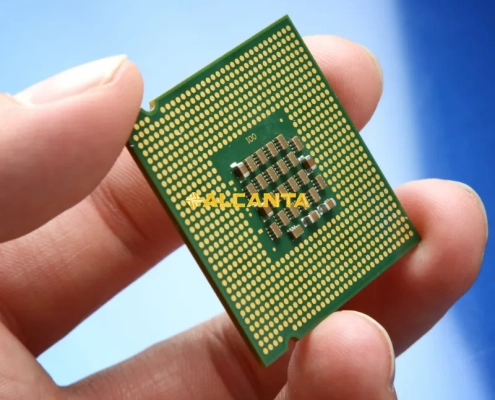Exploring QFP Package Sizes: A Guide for Designers
The QFP (Quad Flat Package) stands as a pivotal component within the realm of Surface Mount Technology (SMT). This acronym, QFP, denotes its distinctive configuration, characterized by a flat and square-shaped body with leads extending from all four sides. These leads, arranged in a grid pattern, facilitate efficient soldering onto the surface of a printed circuit board (PCB). In essence, the term “Quad” signifies the four sides, emphasizing the symmetrical layout.
The significance of QFP in Surface Mount Technology lies in its contribution to miniaturization and enhanced thermal performance in electronic devices. Its compact design and efficient heat dissipation make it a preferred choice for integrated circuits across various industries. As we delve deeper, we’ll explore the physical features, applications, and comparative analyses that make the QFP package an integral element in modern electronics.
QFP Package Features
Physical Characteristics
- Body Size and Shape: The QFP package boasts a distinctive physical appearance characterized by a square-shaped body. The body size varies across different models and applications, ranging from smaller versions for space-constrained devices to larger ones for applications demanding higher pin counts. The square shape ensures efficient use of PCB real estate, contributing to the overall miniaturization trend in electronics.
- Lead Configuration: The leads, or pins, of the QFP package extend from all four sides in a grid-like pattern. The number of leads varies, providing flexibility for accommodating diverse pin configurations based on the complexity of the integrated circuit. The symmetrical arrangement simplifies the soldering process during assembly, ensuring a secure and reliable connection to the PCB.
Advantages of QFP Packages
- Compact Design: One of the key advantages of QFP packages is their compact design. The square shape and grid-like arrangement of leads allow for a high lead count in a relatively small space. This feature is particularly valuable in applications where board space is limited, enabling the integration of complex electronic components into smaller form factors, such as mobile devices and compact consumer electronics.
- Enhanced Thermal Performance: QFP packages exhibit excellent thermal performance due to their flat and exposed nature. The flat surface area facilitates efficient heat dissipation, preventing the buildup of thermal stress on the integrated circuit. This is crucial for maintaining the reliability and longevity of electronic components, especially in applications where temperature management is critical, such as high-performance computing, automotive electronics, and industrial control systems.
The physical characteristics and inherent advantages of QFP packages make them a preferred choice for designers seeking a balance between compact design and optimal thermal performance in a wide range of electronic applications.
QFP vs. QFN
QFP vs. LQFP
Definition and Features of LQFP Package
The LQFP (Low-Profile Quad Flat Package) is a variation of the traditional QFP design, introducing modifications to address specific design considerations. LQFP retains the square shape but features a reduced overall height, contributing to its designation as a “low-profile” package. This adjustment is particularly beneficial in applications where space constraints are paramount.
Comparative Analysis of QFP and LQFP
- Lead Pitch: The primary distinction between QFP and LQFP lies in the lead pitch, which refers to the distance between the centers of adjacent leads. LQFP typically has a smaller lead pitch compared to standard QFP, allowing for a higher lead density in a given space. This finer pitch enhances the package’s ability to accommodate more pins, making it suitable for applications demanding higher pin counts.
- Size Variations: While both QFP and LQFP packages come in various sizes, LQFP is often available in smaller dimensions. The reduced height and finer lead pitch contribute to a more compact form factor. This size advantage makes LQFP a preferred choice in situations where board real estate is limited, such as in compact consumer electronics and portable devices.
- Applications and Use Cases: QFP and LQFP packages find application across a spectrum of industries, but their specific use cases differ based on design requirements. QFP’s versatility makes it suitable for a range of applications, including microcontrollers, digital signal processors, and general-purpose integrated circuits. LQFP, with its reduced profile and enhanced pin density, is well-suited for applications requiring a balance between compact design and increased functionality, such as in automotive electronics, communication devices, and industrial control systems.
The choice between QFP and LQFP involves considerations of lead pitch, size variations, and the specific demands of the intended application. Designers must weigh the advantages of a low-profile form factor and increased pin density when opting for LQFP over the traditional QFP package.
QFP IC (Integrated Circuits)
Role of QFP Packages in Integrated Circuits
The QFP package plays a pivotal role in the realm of integrated circuits, serving as a housing and connection interface for a diverse range of electronic components. Its design facilitates the secure integration of microcontrollers, microprocessors, and various digital and analog ICs onto printed circuit boards (PCBs). The symmetrical grid of leads allows for efficient and reliable soldering, ensuring a stable connection between the IC and the PCB.
Beyond providing a physical housing, QFP packages contribute significantly to the thermal management of integrated circuits. The flat and exposed nature of the package aids in dissipating heat generated during the operation of the IC. This thermal efficiency is crucial in maintaining the reliability and optimal performance of integrated circuits, especially in applications with high processing demands.
Examples of ICs commonly using QFP Packages
- Microcontrollers: QFP packages are commonly employed in microcontrollers due to their ability to accommodate a moderate to high pin count. Microcontrollers used in embedded systems, industrial automation, and consumer electronics often utilize QFP packages, providing a balance between functionality and board space.
- Digital Signal Processors (DSPs): Digital Signal Processors, which are integral to signal processing applications such as audio and image processing, frequently utilize QFP packages. The package’s grid layout is conducive to the intricate pin configurations associated with DSPs, supporting efficient data processing.
- Application-Specific Integrated Circuits (ASICs): ASICs designed for specific applications, where custom functionality is essential, are often housed in QFP packages. The flexibility in pin count and the reliable soldering interface make QFP an ideal choice for ASICs catering to diverse industrial and consumer needs.
- Memory ICs: Some memory ICs, including Flash memory and EEPROMs, are commonly packaged in QFP. The package’s versatility allows for the integration of memory components with varying storage capacities into electronic devices like smartphones, tablets, and digital cameras.
QFP packages serve as an integral component in the world of integrated circuits, offering a versatile and reliable solution for a broad spectrum of applications. The examples provided underscore the adaptability of QFP packages across different IC types, emphasizing their importance in contemporary electronic designs.
QFP Package Sizes
Overview of Various QFP Package Sizes
QFP packages come in a variety of sizes, offering flexibility to designers based on the specific requirements of their applications. The size of a QFP package is typically denoted by the number of leads and the pitch between them. Commonly encountered sizes include:
- Small QFP (SQFP): Typically ranges from 32 to 100 leads, suitable for compact electronic devices with limited board space.
- Standard QFP: With lead counts ranging from 100 to 256, standard QFP sizes find applications in a wide array of electronic devices, including microcontrollers, memory ICs, and digital signal processors.
- Large QFP (LQFP): Featuring lead counts beyond 256, LQFP is ideal for applications requiring a higher pin density. These larger packages are often employed in advanced microprocessors, complex ASICs, and other sophisticated integrated circuits.
Application Specifics for Different Sizes
- Small QFP (SQFP)
- Applications: SQFP packages are commonly used in handheld electronic devices such as smartphones, wearables, and portable medical devices.
- Specifics: The compact size of SQFP allows for space-efficient integration in devices where miniaturization is paramount.
- Standard QFP
- Applications: Standard QFP sizes are versatile and find use in a broad range of applications, including consumer electronics, automotive control systems, and industrial automation.
- Specifics: The moderate lead count makes standard QFP suitable for various integrated circuits, striking a balance between functionality and board space.
- Large QFP (LQFP)
- Applications: LQFP packages are employed in applications demanding higher pin counts, such as advanced microprocessors, graphics processing units (GPUs), and complex ASICs.
- Specifics: The larger size allows for a more extensive array of pins, accommodating the intricate configurations required by high-performance and specialized integrated circuits.
Understanding the nuances of different QFP package sizes enables designers to select the most appropriate option for their specific application. Whether prioritizing miniaturization, functionality, or a high pin count, the variety of QFP sizes caters to the diverse needs of the electronics industry.
PLCC and SOIC Packages
Brief Introduction to PLCC and SOIC Packages
- PLCC (Plastic Leaded Chip Carrier): PLCC is a type of integrated circuit package characterized by a square or rectangular plastic housing and leads that extend from all four sides. The leads are arranged in a grid, similar to QFP, but PLCC typically has gull-wing-shaped leads that extend diagonally from the corners.
- SOIC (Small Outline Integrated Circuit): SOIC is a compact surface-mount IC package known for its small form factor. It has a rectangular shape with leads extending from two opposite sides. SOIC packages are commonly used in various electronic applications due to their space-saving design.
Comparative Analysis with QFP
- Physical Characteristics:
- PLCC:
- Shape: Square or rectangular.
- Leads: Typically have gull-wing-shaped leads extending from all four sides.
- Package Size: Moderate in size, providing a balance between space efficiency and ease of handling during assembly.
- SOIC:
- Shape: Rectangular.
- Leads: Leads extend from two opposite sides in a straight or gull-wing configuration.
- Package Size: Compact, designed for space-constrained applications.
- PLCC:
- Applications:
- PLCC:
- Applications: PLCC packages are commonly used in applications where a higher lead count is required, such as microcontrollers, memory ICs, and programmable logic devices.
- Specifics: The gull-wing lead configuration enhances thermal performance and facilitates automated assembly processes.
- SOIC:
- Applications: SOIC packages find extensive use in a variety of applications, including analog and digital ICs, operational amplifiers, and voltage regulators.
- Specifics: The compact size makes SOIC well-suited for applications where board space is limited, such as in consumer electronics and portable devices.
- PLCC:
Comparing PLCC, SOIC, and QFP packages reveals their distinct characteristics, catering to different requirements in electronic designs. While QFP packages offer a balance between compact design and pin density, PLCC and SOIC packages specialize in unique configurations and applications, emphasizing the importance of selecting the right package based on specific project needs.
TQFP Package
Introduction to TQFP
TQFP, or Thin Quad Flat Package, represents an evolution in the design of QFP packages, introducing modifications to enhance the overall profile and performance. As the name suggests, the TQFP package is characterized by a thinner profile compared to traditional QFP, contributing to its popularity in modern electronic applications.
Key Differences with Traditional QFP Packages
- Reduced Thickness
- Traditional QFP: Characterized by a standard thickness suitable for various applications.
- TQFP: Notably thinner, contributing to an overall reduction in the component’s height. This reduction is advantageous in applications where a low-profile design is critical, such as slim consumer electronics and space-constrained environments.
- Fine Pitch and Higher Lead Density
- Traditional QFP: Features a grid of leads with a moderate pitch suitable for a range of pin counts.
- TQFP: Exhibits a finer lead pitch, allowing for a higher lead density in a given space. This characteristic makes TQFP particularly well-suited for applications requiring more extensive pin configurations, such as advanced microcontrollers and digital signal processors.
- Enhanced Thermal Performance
- Traditional QFP: Offers efficient thermal performance due to its flat design and exposed leads.
- TQFP: Retains these thermal advantages while further optimizing heat dissipation due to its reduced thickness. This feature is especially valuable in applications where thermal management is critical, such as in high-performance computing and power electronics.
- Miniaturization and Space Efficiency
- Traditional QFP: Balances functionality with a moderate size, suitable for a range of applications.
- TQFP: Emphasizes miniaturization and space efficiency, making it an ideal choice in modern electronic designs where compact form factors are essential. Its reduced thickness and fine pitch contribute to the component’s ability to fit into increasingly smaller devices.
In summary, the TQFP package builds upon the foundation of traditional QFP, introducing key enhancements in thickness, lead density, and thermal performance. These improvements cater to the evolving demands of electronic designs, particularly in applications where a low-profile, high-density solution is paramount.
What is a QFP package?
A QFP (Quad Flat Package) is an integrated circuit package characterized by a square or rectangular shape with leads extending from all four sides. These leads are arranged in a grid pattern, facilitating surface mounting on a printed circuit board (PCB).
What is the difference between QFN and QFP?
The main difference lies in the lead configuration. QFN (Quad Flat No-Lead) packages have no leads on the sides, and the electrical connections are located on the bottom surface. In contrast, QFP has leads extending from all four sides. Additionally, QFN is generally leadless, contributing to a more compact form factor.
What is the difference between QFP and LQFP package?
The primary difference is in the lead pitch and size. LQFP (Low-Profile Quad Flat Package) has a smaller lead pitch compared to traditional QFP, allowing for a higher lead density. LQFP also has a reduced overall height, making it more suitable for applications where space constraints are crucial.
What is the full form of QFP in SMT?
The full form of QFP in SMT is “Quad Flat Package” – a packaging technology commonly used in Surface Mount Technology (SMT) for mounting integrated circuits on printed circuit boards.



